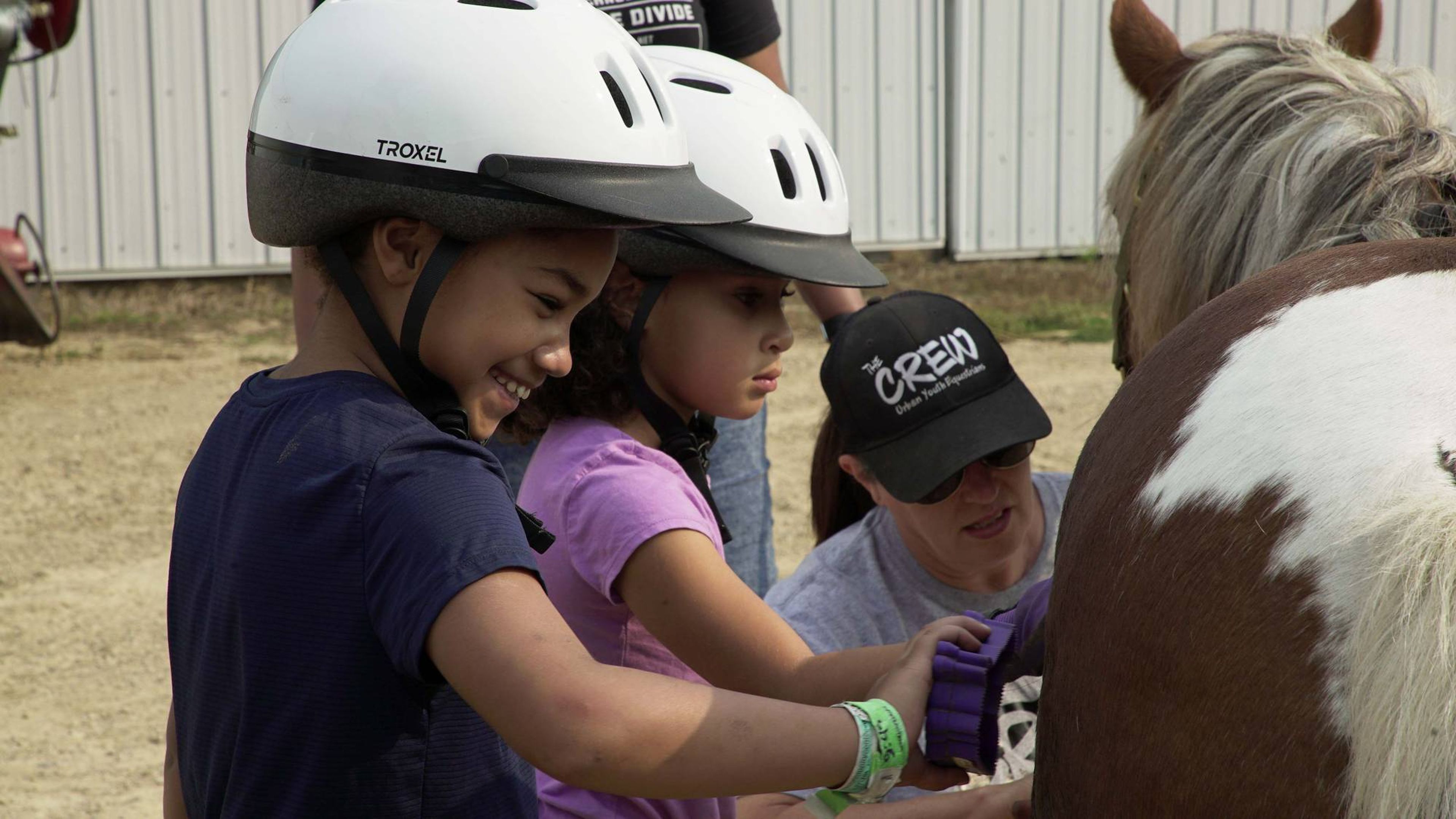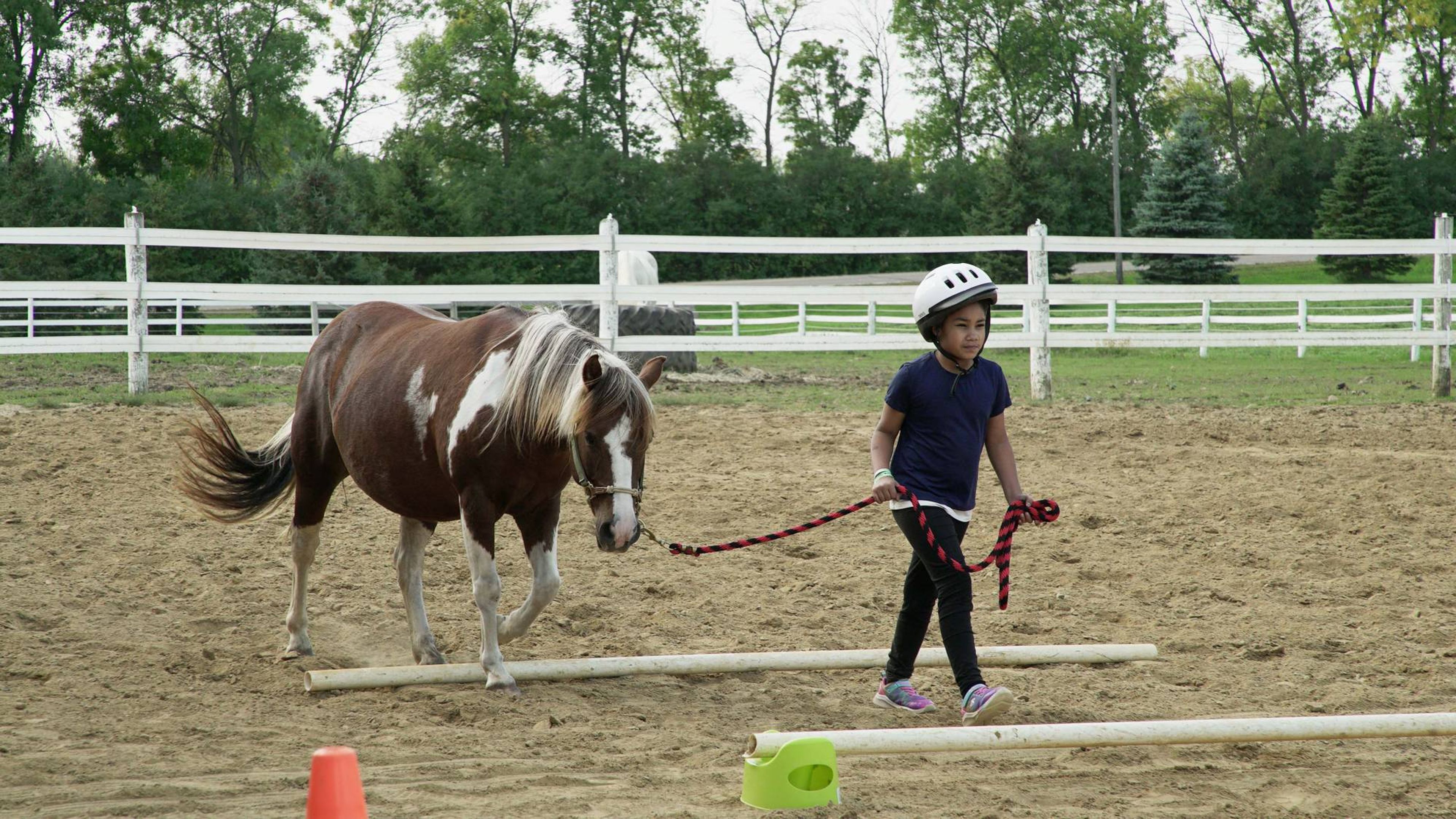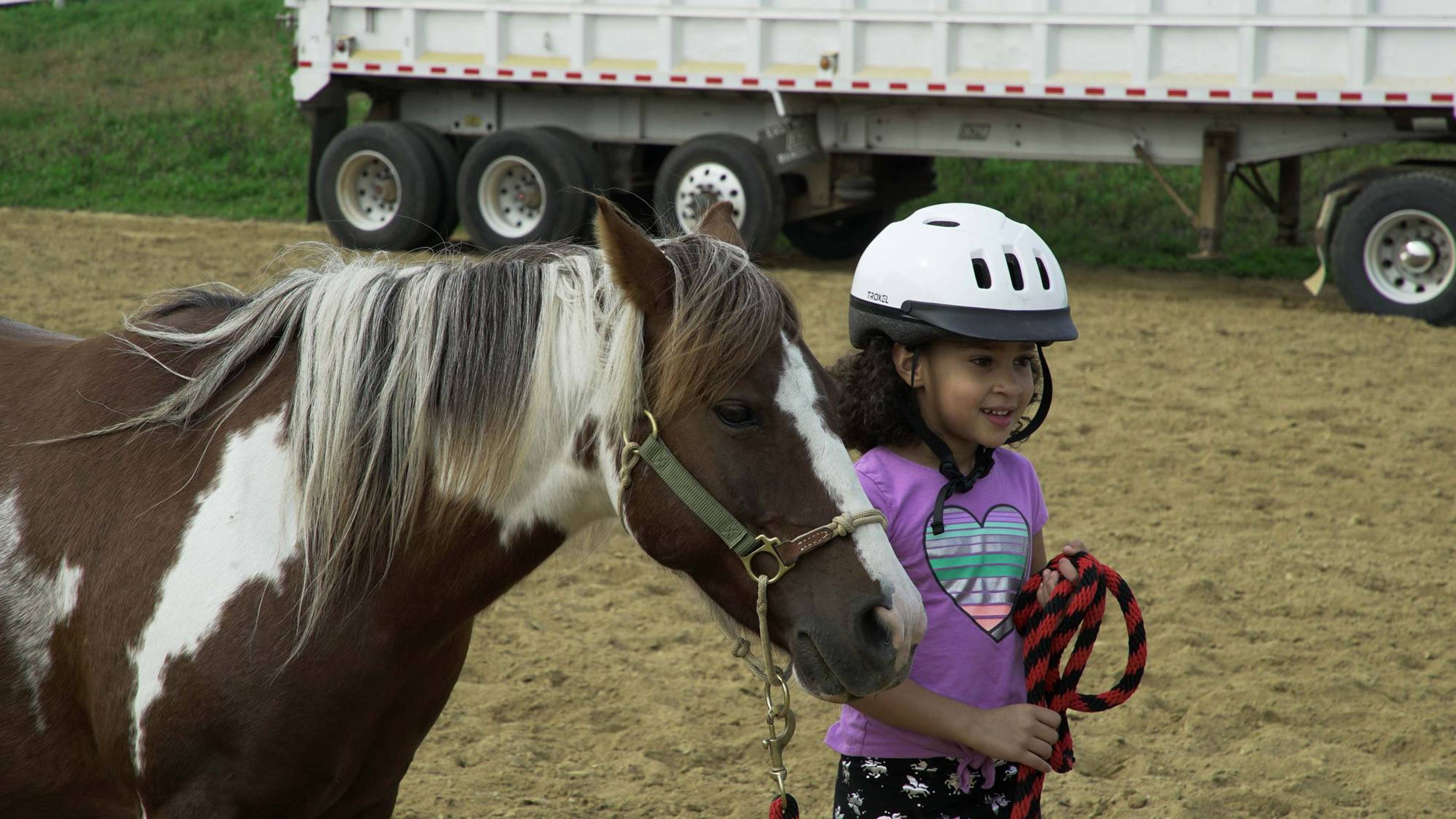How The CREW Connects BIPOC Youth to Horses and Hopes to Change Lives
Racial gatekeeping often prevents kids of color from experiencing equine sports and the great outdoors.

Across a pasture of tall grass, brown, black and white horses munch on hay and shake their manes in the wind. Behind a stable, Hannah Mordan, 9, and Raquel Mordan, 8, brush Paprika - a Welsh pony - and clean her hooves. Hannah and Raquel's mom, Noemi Arocho, brings them to the Strofus Stock Farm almost every weekend for the girls to learn about horses and connect with nature through the CREW Urban Youth Equestrians.
Paprika and Samir, an Arabian-cross gelding, belong to Jenny Benton, one of the co-founders of the CREW, which stands for Community, Relationship, Empowerment and Well-being.
Benton, along with her childhood friends Kenatia Gilmer and Chauntel Allen, co-founded the CREW in order to create a space for urban American descendants of slaves, Indigenous/Native, Hispanic/Latino, Asian and all youth of color in Saint Paul and Minneapolis to discover confidence and power in themselves through horses. Hannah and Raquel were the first to sign up for lessons when the CREW opened shop in March 2021.
"They often say that this is their happy place, and so that says to me that this is filling their hearts," Arocho said. "For me, it was important for my girls to connect with nature at an early age, because it took me until later on in life, being an adult, to be able to really appreciate and love nature."
Arocho grew up in a first-generation immigrant household. Her family is from the Dominican Republic and, while growing up she was able to occasionally go to the Dominican Republic to see family and be in nature, most of her life was in an urban setting without much access to natural spaces and outdoor activities.
Because her mom was a single business woman, Arocho had to grow up at an early age, she recalls. But she wants her children to really enjoy their childhood - and part of that involves connecting with nature.
Both Hannah and Raquel love horses, and their mother has made an effort to try to find opportunities for the girls to be around them and learn more. But as a family of color, they've experienced feeling "othered" in equine spaces, with Arocho even saying she goes out of her way to dress in a way that prevents others from confusing her as "the help."
"In certain spaces, we are looked at like we don't belong, and I could say honestly, we probably don't, based on their mindset," Arocho said. "There are very few families that have opportunities like this, and that's where I think Jenny comes in, and the CREW comes in, and opens spaces."
Processing Trauma
Kenatia Gilmer recalls one particular day, in the thick of the pandemic and right after George Floyd was murdered by Minneapolis Police Officer Derek Chauvin, when the uprising took over the city. Gilmer, being the oldest, invited her cousins and their families over to grieve Floyd's death and the violence that had increased against the Black community.
All the kids were sitting in the stairwell talking about how they felt, expressing frustration because they couldn't see or talk to their friends at school and sharing feelings of anger and hurt about George Floyd's murder.
"'Why is this happening? And is this going to keep happening, like do I have to worry about my dad, too? What about me when I grow up?'" Gilmer remembers the kids asking. "It just dawned on me that there's a lot of adult conversations happening, but not a lot of space for children."
A few days later, Jenny Benton happened to reach out to Gilmer and her younger sister, Chauntel Allen. Friends since they were kids, the three discussed the lack of spaces for youth to work through their trauma and emotions. Benton offered that she had been thinking of a youth program for this exact issue. What if they started a nonprofit to create a safe space for kids to be around horses?

While Gilmer and Allen had family in the South, where they were used to Black folks riding and owning horses, they developed a different view of horses and who was able to ride them as a Black family in Minnesota.
"You're not seeing people outside of police officers walking around on horses. That was our experience," Allen said. "What that said [to me] was, authority. 'I'm an authoritative figure, and I ride horses. I stand above you. You're beneath me.' That's what I felt as a child."
But Benton, who's white, had a very different experience with horses in her youth: They provided a safe space for her.
"I had my first horse when I was 15 or 16, and it literally saved my life," Benton said. "Going to the barn for me was my way to work through whatever trauma I was going through."
The three old friends, along with Benton's nieces and now board members, Dorine Jinkins and Jestine Jinkins, got to work hammering out the details of the kids they would serve and how they would make this idea possible.
Ultimately, they came up with a plan to start a student-led program where the youth set the pace because, Allen says, kids have so few opportunities to be in control and make decisions. She also says that working with Benton's rescue horses is so important for youth to learn about mental health, having an awareness of others and having confidence in their own voices.
"That is so educational for the children, to be patient and to really watch what [the rescue horse is] communicating, and just let him be, and see what he really wants to do."
Starting on the ground, the students in the program learn the basics about taking care of horses and slowly work their way up to riding them over a series of weeks. By learning to build trust, communication skills and a sense of community, the co-founders hope the program will have lasting and profound impacts on the lives of the kids who participate.
Today, there are 20 kids in the program. Lessons, which usually run an hour-and-a-half to two hours, are $20. In launching the program, it was important to the co-founders that it be an affordable option. To that end, they have a policy that they will never turn away a child, including for an inability to pay.

Gatekeeping in the Outdoors
While affordability is certainly an issue, basic access has historically been a key barrier when it comes to Black, Indigenous and communities of color utilizing and partaking in outdoor activities.
Dr. KangJae "Jerry" Lee, an assistant professor at the College of Natural Resources, Department of Parks, Recreation and Tourism Management at North Carolina State University, has written and published research on how African Americans and other communities of color have systematically been cut off from accessing public parks, travel and other outdoor activities.
Lee said that initially American settlers didn't perceive the natural environment as desirable because they had to overcome and tame it for agriculture in order to survive. But in the mid- to late-1800s, with urbanization, the white, powerful conservation and park leaders started to romanticize nature for the first time, and created an implicit binary between nature and city life.
"In this implicit city-nature binary, nature was viewed as a desirable environment and a get-away from many urban problems such as crowding, poor housing and sanitations, and… a lot of immigrants and people of color."
Lee goes further, explaining that conservationists, such as Madison Grant, Theodore Roosevelt and Gifford Pinchot, who played a critical role in creating national parks, were eugenicists and expressed little-to-no interest in racial and ethnic inclusivity in nature.
"Those three individuals were eugenicists who believed in white supremacism. And, one of the main reasons they wanted to preserve nature was because they believed nature was the perfect context for the white race to thrive," Lee says. "Basically, they equated conservation, such as creating national parks and forests, as a means of white race preservation and the nation's advancement."
Prior to the Civil Rights Act of 1964, many people of color were barred from, or segregated at public recreational sites.
These historical contexts had a significant impact on the access communities of color had to the many mental and physical benefits that outdoor recreation provides. And because many of the skills and knowledge for outdoor activities are passed down from generation to generation, these negative experiences with outdoor spaces have had lasting impacts.
"Their grandparents, their great grandparents, they were not able to enjoy these natural amenities, and if they did so they may have risked their lives," Lee says.
That is why the CREW and other programs like it are important. They are trying to rid the stigma around outdoor spaces and instill natural knowledge in younger generations.
Despite the fact that the equine community is predominantly white, the co-founders shared that they've received an outpouring of support from the community and hope to continue to grow.
"This space has been closed off to families of color, and that's not okay. What we're building at the CREW is changing the perception of who gets to be an equestrian," Benton said. "[The kids in the program] own this space, this is their time. They own it."

The Racism Unveiled digital storytelling project is funded by grants from the Otto Bremer Trust, HealthPartners and the Saint Paul & Minnesota Foundation.
A second pandemic school year is underway, and one debate is heating up among, educators, administrators and parents: Should critical race theory (CRT), a legal framework developed in the mid 1970s that examines how institutions and laws perpetuate systemic racism, be part of school curricula?
With media that spans the spectrum from reality shows that depict cops stopping, detaining and arresting people of color, to the endless news and social media cycles surrounding the police killing of George Floyd and other Black people, children are sometimes exposed to words and images that they can't understand. In this bonus episode of Trial & Tribulation: Racism and Justice in Minnesota, we spoke with child therapy expert Dr. BraVada Garrett-Akinsanya about some tips caregivers can use to help kids cope.
